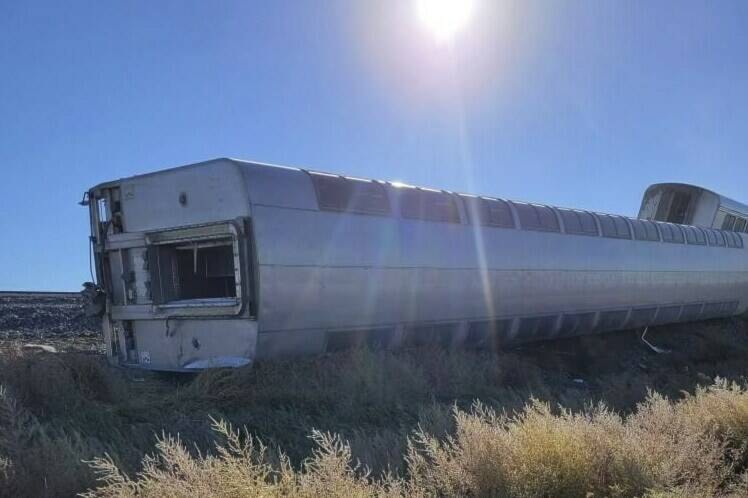Federal officials sent a team of investigators from the National Transportation Safety Board to the site of an Amtrak derailment in north-central Montana that killed three people and left seven hospitalized Sunday, officials said.
The westbound Empire Builder was en route to Seattle from Chicago, with two locomotives and 10 cars, when it left the tracks about 4 p.m. Saturday near Joplin, a town of about 200.
The train was carrying about 141 passengers and 16 crew members and had two locomotives and 10 cars, eight of which derailed, Amtrak spokesman Jason Abrams said.
A 14-member team including investigators and specialists in railroad signals would look into the cause of the derailment on a BNSF Railway main track that involved no other trains or equipment. said NTSB spokesman Eric Weiss.
The accident scene is about 150 miles (241 kilometers) northeast of Helena and about 30 miles (48 kilometers) from the Canadian border.
Most of those on the train were treated and released for their injuries, but five who were more seriously hurt remained at the Benefis Health System hospital in Great Falls, Montana, said Sarah Robbin, Liberty County emergency services coordinator. Two were in the ICU, another spokeswoman said.
Another two people were at Logan Health, a hospital in Kalispell, Montana, spokeswoman Melody Sharpton said.
Liberty County Sheriff Nick Erickson said the names of the dead would not be released until relatives are notified.
Robbin said nearby residents rushed to offer help when the derailment occurred.
“We are so fortunate to live where we do, where neighbors help neighbors,” she said.
Amtrak said it sent emergency personnel and other officials to the site to help passengers, employees and local officials. It said company officials were “deeply saddened” to learn of the deaths.
Because of the derailment, Sunday’s westbound Empire Builder from Chicago will terminate in Minneapolis, and the eastbound train will originate in Minneapolis.
Passenger Megan Vandervest told The New York Times she was awakened by the derailment.
“My first thought was that we were derailing because, to be honest, I have anxiety and I had heard stories about trains derailing,” said Vandervest, of Minneapolis. “My second thought was that’s crazy. We wouldn’t be derailing. Like, that doesn’t happen.”
She told the Times that the car behind hers was tilted, the one behind that was tipped over, and the three cars behind that “had completely fallen off the tracks and were detached from the train.”
Speaking from the Liberty County Senior Center, where some passengers were being taken, Vandervest said it felt like “extreme turbulence on a plane.”
Residents of communities near the crash site quickly mobilized to help.
Chester Councilwoman Rachel Ghekiere said she and others helped about 50 to 60 passengers who were brought to a school.
“I went to the school and assisted with water, food, wiping dirt off faces,” she said. “They appeared to be tired, shaken but happy that they were where they were. Some looked more disheveled than others, depending where they were on the train.”
A grocery store in Chester, about 5 miles (8 kilometers) from the derailment, and a nearby religious community provided food, she said.
The passengers were taken by buses to hotels in nearby Shelby, said Ghekiere, whose husband works for the local emergency services agency and was alerted to the crash.
Photos on social media showed rail cars on their sides and passengers standing alongside the tracks, some carrying luggage. The images showed sunny skies, and it appeared the accident occurred along a straight section of tracks.
Allan Zarembski, director of the University of Delaware’s Railway Engineering and Safety Program, said he didn’t want to speculate but suspected the derailment stemmed from an issue with the train track or equipment, or a combination of both.
Railways have “virtually eliminated” major derailments by human error after the implementation of positive train control nationwide, Zarembski said.
“I would be surprised if this was a human-factor derailment,” Zarembski said.
NTSB findings could take months, he added.
Bob Chipkevich, who oversaw railroad crash investigations for several years at the NTSB, said the agency won’t rule out human error or any other potential causes for now.
“There are still human performance issues examined by NTSB to be sure that people doing the work are qualified and rested and doing it properly,” Chipkevich said.
Chipkevich said track conditions have historically been a significant cause of train accidents. He noted most of the track that Amtrak uses is owned by freight railroads and it depends on those companies for safety maintenance.
Other recent Amtrak derailments include:
— April 3, 2016: Two maintenance workers were struck and killed by an Amtrak train going more than 100 mph in Chester, Pennsylvania. The lead engine of the train derailed.
— March 14, 2016: An Amtrak train traveling from Los Angeles to Chicago derailed in southwest Kansas, sending five cars off the tracks and injuring at least 32 people. Investigators concluded that a cattle feed delivery truck hit the track and shifted it at least a foot before the derailment.
— Oct. 5, 2015: A passenger train headed from Vermont to Washington, D.C., derailed when it hit rocks that had fallen onto the track from a ledge. The locomotive and a passenger car spilled down an embankment, derailing three other cars and injuring seven people.
— May 12, 2015: Amtrak Train 188 was traveling at twice the 50 mph speed limit as it entered a sharp curve in Philadelphia and derailed. Eight people were killed and more than 200 were injured when the locomotive and four of the train’s seven passenger cars jumped the tracks. Several cars overturned and ripped apart.
__
Snow reported from Phoenix. Associated Press writers Tom Krisher in Detroit, Martha Bellisle in Seattle and Michelle Liu in Columbia, South Carolina, contributed.
Amy Beth Hanson And Anita Snow, The Associated Press
Like us on Facebook and follow us on Twitter.
